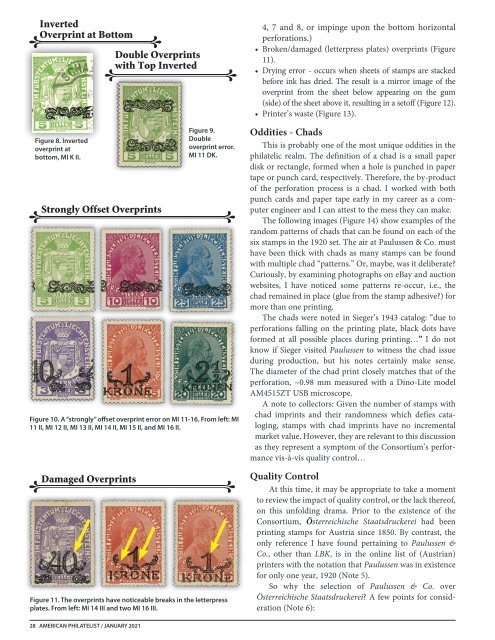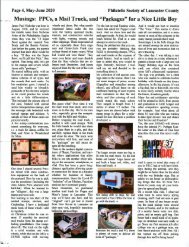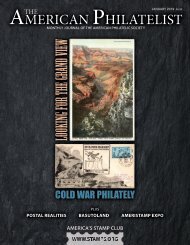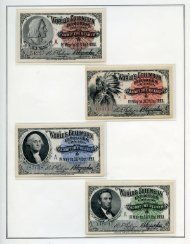221JANAP_web
You also want an ePaper? Increase the reach of your titles
YUMPU automatically turns print PDFs into web optimized ePapers that Google loves.
Inverted<br />
Overprint at Bottom<br />
Figure 8. Inverted<br />
overprint at<br />
bottom, MI K II.<br />
Double Overprints<br />
with Top Inverted<br />
Strongly Offset Overprints<br />
Figure 10. A “strongly” offset overprint error on MI 11-16. From left: MI<br />
11 II, MI 12 II, MI 13 II, MI 14 II, MI 15 II, and MI 16 II.<br />
Damaged Overprints<br />
Figure 9.<br />
Double<br />
overprint error.<br />
MI 11 DK.<br />
Figure 11. The overprints have noticeable breaks in the letterpress<br />
plates. From left: MI 14 III and two MI 16 III.<br />
4, 7 and 8, or impinge upon the bottom horizontal<br />
perforations.)<br />
• Broken/damaged (letterpress plates) overprints (Figure<br />
11).<br />
• Drying error - occurs when sheets of stamps are stacked<br />
before ink has dried. The result is a mirror image of the<br />
overprint from the sheet below appearing on the gum<br />
(side) of the sheet above it, resulting in a setoff (Figure 12).<br />
• Printer’s waste (Figure 13).<br />
Oddities - Chads<br />
This is probably one of the most unique oddities in the<br />
philatelic realm. The definition of a chad is a small paper<br />
disk or rectangle, formed when a hole is punched in paper<br />
tape or punch card, respectively. Therefore, the by-product<br />
of the perforation process is a chad. I worked with both<br />
punch cards and paper tape early in my career as a computer<br />
engineer and I can attest to the mess they can make.<br />
The following images (Figure 14) show examples of the<br />
random patterns of chads that can be found on each of the<br />
six stamps in the 1920 set. The air at Paulussen & Co. must<br />
have been thick with chads as many stamps can be found<br />
with multiple chad “patterns.” Or, maybe, was it deliberate?<br />
Curiously, by examining photographs on eBay and auction<br />
<strong>web</strong>sites, I have noticed some patterns re-occur, i.e., the<br />
chad remained in place (glue from the stamp adhesive?) for<br />
more than one printing.<br />
The chads were noted in Sieger’s 1943 catalog: “due to<br />
perforations falling on the printing plate, black dots have<br />
formed at all possible places during printing…” I do not<br />
know if Sieger visited Paulussen to witness the chad issue<br />
during production, but his notes certainly make sense.<br />
The diameter of the chad print closely matches that of the<br />
perforation, ~0.98 mm measured with a Dino-Lite model<br />
AM4515ZT USB microscope.<br />
A note to collectors: Given the number of stamps with<br />
chad imprints and their randomness which defies cataloging,<br />
stamps with chad imprints have no incremental<br />
market value. However, they are relevant to this discussion<br />
as they represent a symptom of the Consortium’s performance<br />
vis-à-vis quality control…<br />
Quality Control<br />
At this time, it may be appropriate to take a moment<br />
to review the impact of quality control, or the lack thereof,<br />
on this unfolding drama. Prior to the existence of the<br />
Consortium, Österreichische Staatsdruckerei had been<br />
printing stamps for Austria since 1850. By contrast, the<br />
only reference I have found pertaining to Paulussen &<br />
Co., other than LBK, is in the online list of (Austrian)<br />
printers with the notation that Paulussen was in existence<br />
for only one year, 1920 (Note 5).<br />
So why the selection of Paulussen & Co. over<br />
Österreichische Staatsdruckerei? A few points for consideration<br />
(Note 6):<br />
28 AMERICAN PHILATELIST / JANUARY 2021

















